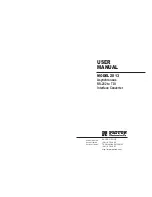
I-7530A-MR Modbus RTU to CAN
Converter User’s Manual (Version 1.08, 07/2019) ------------- 20
2.7
Cable Selection
The CAN bus is a balanced (differential) 2-wire interface running over
either a Shielded Twisted Pair (STP), Un-shielded Twisted Pair (UTP), or
Ribbon cable. The CAN-L and CAN-H Wire start on one end of the total
CAN network that a terminator of 120 Ohm is connected between CAN-L
and CAN-H. The cable is connected from CAN node to CAN node,
normally without or with short T connections. On the other end of the
cable again a 120
Ω
(Ohm) terminator resistor is connected between the
CAN lines. How to decide a cable type, cable length, and terminator
depends on the baud rate in the CAN bus network, please refer to the
following table 2-4.
Figure 2-18
:
Un-shielded Twisted Pair (UTP)
Table 2-4: Cable selection
Bus speed
Cable type
Cable
Resistance/m
Terminator Bus Length
50k bit/s
at 1000m
0.75~0.8mm2
18AWG
70 mOhm
150~300
Ohm
600~1000m
100k bit/s
at 500m
0.5~0.6 mm2
20AWG
< 60 mOhm
150~300
Ohm
300~600m
500k bit/s
at 100m
0.34~0.6mm2
22AWG, 20AWG
< 40 mOhm
127 Ohm
40~300m
1000k bit/s
at 40m
0.25~0.34mm2
23AWG, 22AWG
< 40 mOhm
124 Ohm
0~40m
Note:
The AWG means a standard method used to measure wire. The
numbering system works backwards from what people would think, the
thicker (heavier) the wire, the lower the number. For example: a 24AWG
wire is thicker/heavier than a 26AWG wire.
















































